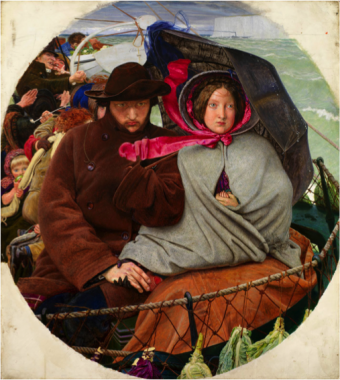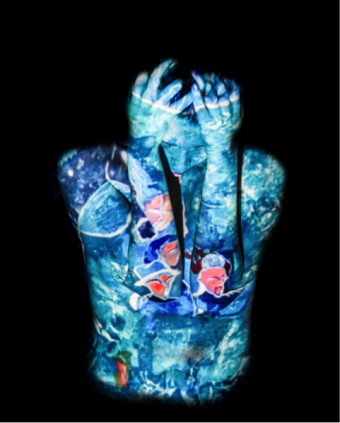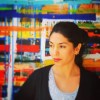Over 150 years have passed since Ford Madox Brown painted The Last of England, the famous painting that portrayed the artist’s family along with others voyaging towards an uncertain future in Australia (Figure 1). Australia is now much more vibrant and multi-cultural since the time of first white settlement and the European Immigration Movement in 1840s.

Events such as BrisAsia, in my view, open effective platforms to enhance Australia’s art industry to a much richer space. Yum Chat gathered dedicated art practitioners of Asian background who devote themselves to the lofty task of bridging their ancestors’ culture with Australian art scenery, and explore the complexities of ethnical and cultural identity within their practices.
Asia is home to the most ancient civilizations on earth. Although the terms Asian Art, Asian people and Orientals generally refer to a number of countries in South and East Asia, the continent itself has more than 48 countries and hence there is a diverse circle of cultures and languages.
I was born and raised in Iran, a country of great contrasts, a land of ancient civilization, mythology, art, natural treasures, oil, political contradictions, fraud and dictatorship. I left Iran in 2010 and joined the other six million diasporic Iranians dispersed in different parts of the globe. To me, the past is a strange country with paradoxical qualities. Indeed, it was this fabulous world that contextualised my visions, memories, understandings, emotions, and more. Nevertheless, at the same time it was a country of censorship, autocracy and violation of human rights. The home that I have deliberately left; the home that I do not want to return to!
Like most of displaced people, I have also been faced with dual identity and nostalgia. The dual identity for displaced Iranians begins very early after their immigration. When not among each other, we tend to refer ourselves as “Persian” rather than “Iranian”. This is basically to give a better impression to Westerners and detach ourselves from the political complexities that the Iranian regime imposed in recent decades. Although both terms (Iranian and Persian) refer to the same people and same country, surprisingly Persian invokes better connotation for westerners rather than Iranian. However, ‘Iran’ is as old as ‘Persia’ in terms of historical usage of the word, and surprisingly has no literal attachment with the Islamic regime.
Speaking of identity, I would like to take this discussion to another level. Recent scientific discoveries showed that despite all their physical differences, 99.9 per cent of humans from all over the world share identical genes and thereby almost all humans are the same (Highfield 2002). Likewise, psychoanalysts and scholars such as Carl Gustav Jung and Joseph Campbell believed that despite the different appearances, all the cultures and mythologies of the world emanate from archetypical features of human psyche and thereby have very similar qualities.
If these two statements are true, then all of our conceptions on national identity may need to be reevaluated. We should also take into consideration that a shared foundation is the basis of all diverse features of cultures. In fact, these variances are what make our world beautiful, unless one race forcefully passes off difference as superiority over the others.
As a practitioner in the areas of painting, body art projection and installation, my art is concerned with diasporic identity, gender roles and sense of belonging to place. It is informed by Persian myths and personal memories that have shaped my perceptions.


Now, I would also like to argue that as globalisation is developing in the world, our cultural identities are also becoming more homogenous as well.
Thereby our diasporic identity does not have to fully pinpoint our background culture and ethnicity but since identity is a dynamic process, every new experience, exposure and knowledge is constantly building new identities for us. Diasporic identities are those repetitively producing and reproducing themselves through transformation and difference. I think that identity, at its very core, relates to self-awareness and individuality.
In the diaspora, however, self-awareness seems to assist people to cope with paradoxical feelings of displacement. This is where we better reconcile with our cultural roots, explore our originality and reconstruct those norms into our new environment.
In his renowned book A hero with a thousand stories, Joseph Campbell argued that the first step to survival detachment is to transfer from the external to internal world of self-awareness; a retreat from the drifting labyrinth to the peaceful everlasting realm of originality, where all the magic of uniqueness is still present. This originality is like a golden seed, which will never die (Campbell 1973).
The Aboriginal rock arts in the Grampians national park provide evidence that the human encounter with Australia dates back more than 40,000 years ago. Since then humans have continued to come and settle here. As couriers of Asian cultures, we have also brought new stories to this land. Perhaps our task is to recreate our stories and fit them into the circle of narrations from millions of other people who have lived on this old land. As artists, we better continue getting inspiration from our background culture and narrate those norms through our art, because we are never complete without telling our stories.
—
Campbell, Joseph. 1973. The Hero with a Thousand Faces. Princeton, New Jersey: Princeton University Press.
Highfield, Roger. 2002. “DNA survey finds all humans are 99.9pc the same.” The Telegraph Media Group.

